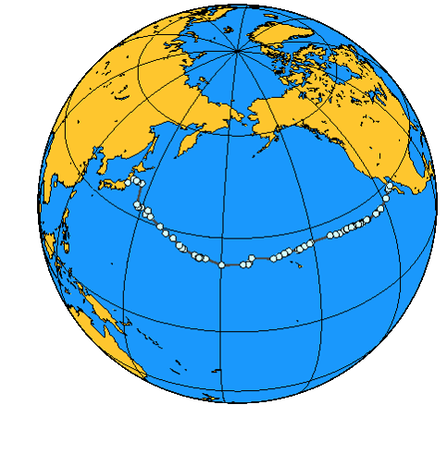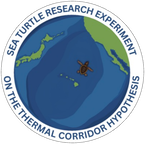The Remarkable Journey of Adelita
|
North Pacific loggerhead sea turtles (Caretta caretta) undergo one of the greatest of all animal migrations, entering the sea as hatchlings in Japan and re-emerging years later along important foraging grounds in the Eastern North Pacific (Briscoe et al. 2021). Yet, the mechanisms that connect these distant habitats have remained poorly understood. Aggregations of juvenile loggerheads were long known to feed along the Pacific coast of Baja California, Mexico, particularly in Bahia de Ulloa. But scientists were unable to locate loggerhead nesting beaches anywhere in the region, making the source of these turtles one of the longest standing mysteries in sea turtle biology.
Twenty-five years ago, a team of marine biologists led by Wallace J Nichols, Jeffrey Seminoff, and Antonio Resendiz released an adult female loggerhead off the coast of Baja California (Nichols et al. 2000). After spending a decade in captivity in an aquarium in Bahia de Los Angeles, it was hoped that this turtle, named Adelita, would provide insight into the “lost years”—the at-sea part of this species’ life history. Outfitted with a satellite tag, Adelita traveled more than 11,500 km in just over a year to reach waters off the coast of Japan! The magnificent journey of Adelita represented the first evidence of a satellite-tracked marine animal crossing an entire ocean basin and allowed scientists to hypothesize population connectivity that up until then, seemed unimaginable. |
Connectivity Through Genetic Analyses
|
Modern mitochondrial DNA markers have since confirmed that loggerheads in Baja originate in Japan (Bowen et al.1995, Matsuzawa et al. 2016). But until recently, scientists had no clear understanding of the specific mechanisms by which Japanese loggerheads migrate across the entire North Pacific Ocean to the bays of Baja California. Our research group recently analyzed 15 years of data from satellite tagged juvenile loggerheads released in the Western and Central North Pacific. An outcome of this work was a new hypothesis — the “thermal corridor” hypothesis (Briscoe et al. 2021) — which we propose to test by experimentally deploying cohorts of satellite-tagged loggerheads in the Eastern North Pacific across four years of variable environmental conditions. |
Thermal Corridor Hypothesis
|
The "thermal corridor" hypothesis (TCH) proposes a mechanism for habitat connectivity — a “thermal corridor”—that results in intermittent pulses of endangered loggerheads shifting from the Central North Pacific (CNP) high seas to waters near Baja California, Mexico. Our team generated the TCH from the foundation of 18 legacy journal publications and through combining remotely sensed oceanography data and satellite tracks of six juvenile loggerheads that formed part of a 15-year dataset of 231 individuals (1997–2013).
While 97% of individuals remained in the CNP convergence zone, these six turtles continued on an eastward trajectory through one of the oceanic “biogeographic barriers” proposed by Darwin. Importantly, the oceanographic features in this area typically prevent marine organisms from larvae to larger swimming species from passing through. To further examine this phenomenon, we employed an independently derived data set using novel aging and stable isotope analyses of bone growth layers of loggerheads stranded in Baja and assessed annual recruitment over the same time period (n = 33, 1997–2012). This evidence showed higher recruitment under warm ocean conditions, further supporting the TCH and the notion that pulsed recruitment of loggerheads to the North American coast is likely a function of exceptionally warm oceanographic conditions (Briscoe et al. 2021). Our findings offered, for the first time, the opportunity to explore the development of a dynamic ocean corridor for this endangered species, illuminating a longstanding mystery in sea turtle ecology. |
Interested in more? Read the scientific article outlining the Thermal Corridor Hypothesis:
Your browser does not support viewing this document. Click here to download the document.
Read the full list of North Pacific Loggerhead sea turtle publications here!
Header photo credit: Ralph Pace







